The traditions of the Faroese Boat
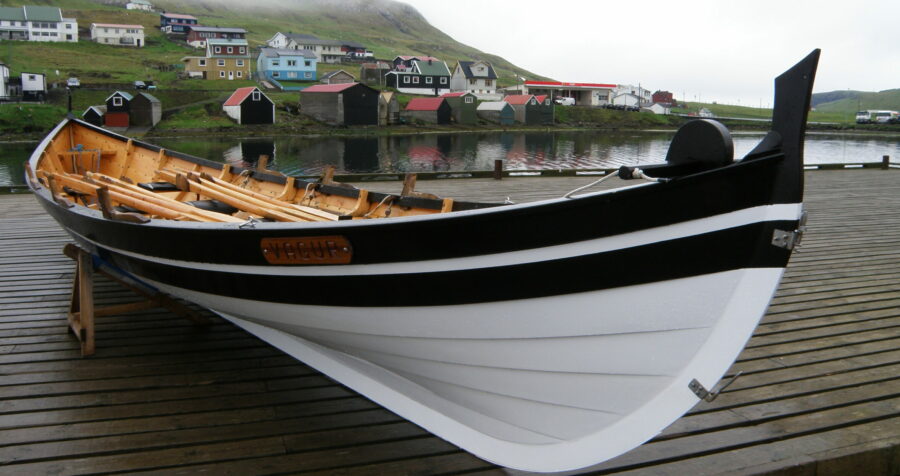
Background
Historically, the Faroese boat has had immense importance for living conditions in the Faroe Islands. The boat has been used for fishing, fowling, whale hunting, in agriculture and for transportation between the islands. Even though the commercial use has been considerably reduced, the Faroese boat is still being used in fishing and for leisure pursuits, as well as in the rowing competitions. The Faroese boat is part of the intangible culture belonging to most people in the Faroe Islands. Many people own a boat or know someone who does.
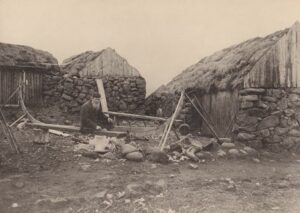
Faroese boatbuilder,
Source :Mortensen, Tórshavn 2000
History and characteristics
The characteristics of the Faroese boat is the construction with keel, boat planks and rowing gear. A clinker-built boat has its keel raised, and the planks are subsequently added edge upon edge and riveted together. The boat is formed gradually as the planks are added. The keel is from oak, and the boat planks are from spruce, pine, or larch wood.
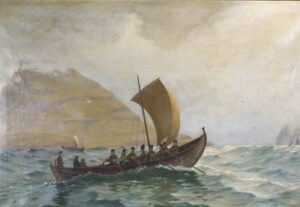
An artist deption of an old faroese boat . Source: Andras Mortensen: The Faroese Rowing Boat. Maritime culture in the Faroe Islands in the old days. (Hin føroyski róðrarbáturin. Sjómentir føroyinga í eldri tíð), Tórshavn 2000
The origin of the Faroese boat is the Nordic clinker-built boat with approximately 2000 years of history. It is believed that the Faroese boat got its beautiful, seaworthy shape in the middle of the 17th century. Lucas Debes writes in 1673 that “…some practice boatbuilding, building the most beautiful boats, light and very advantageous in these dangerous seas, so that the Norwegian boats cannot be compared to the Faroese ones.” The Faroese boat was used for all transportation and for fishery. The boat was adapted to the conditions making it seaworthy and light. In many places the landing conditions are difficult, and where the coastline is steep, the Faroese boat was well suited because it is stable at sea and light to haul ashore.
The building tradition
Faroese boats are not built according to a fixed design, but according to measuring stick, key measurements, and traditions from older skilled craftsmen and by the builder’s eye. A person could call himself a boatbuilder after apprenticeship with an older boatbuilder for two winters and subsequently having built twelve boats. Originally boats were built out of doors. Boatbuilders would travel from village to village with their tools, building boats on the spot. Later other bigger tools were added, and the boats were built inside. The knowledge and skills of boatbuilding were passed on, and special professional environments with boatbuilding as the main profession, were to be found in the Nólsoy and Mikladalur.
How it was done
Safeguarding the Faroese boat traditions
The social significance of the Faroese boat changed in the beginning of the 20th century when it was substituted by bigger boats and ships. However, the Faroese clinker boat is still a significant and visible part of Faroese society.
In Tórshavn the City Council has reserved the innermost spaces at the boat bridges in the harbor – on the Kongabrúgv – for Faroese boats so that they are easily admired, lending a charming atmosphere to the harbor area.
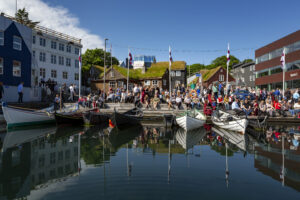
Photo: Ólavur Frederiksen
Several interest groups organize lessons in rowing and sailing for children and young people. They also organize activities and trips with Faroese boats. The organizations do great work by spreading knowledge about the Faroese boat, as well as about rowing and boat building.
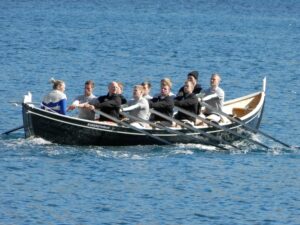
Suðuroyingur is a Faroese wooden rowboat from the island Suðuroy. Photo: Eileen Sandá
CC BY-SA 3.0
https://commons.wikimedia.org/wiki/File:Su%C3%B0uroyingur_a_wooden_Faroese_rowing_boat_2012.JPG
The racing boats are evident around the in the Faroe Islands throughout the summer, and many children, young and adults are active in the many rowing associations in the country. The rowing competition is broadcast live on Faroese Radio, and there is vast interest in rowing competitions among people. The National Rowing Association is actively encouraging interest in the Faroese boat and the rowing competitions in the Faroe Islands.
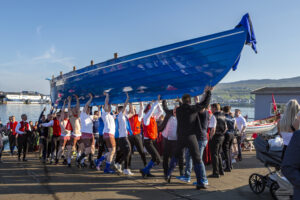
Photo: Ólavur Frederiksen
Boatbuilders receive visitors, both Faroese and foreigners, and several projects are being planned to create living museums with boats and boatbuilding.
The future of the Faroese boat traditions
There is great interest in the Faroese boat, and given all the activities instigated by individuals and associations its prospects seem good – at least for some time.
However, the expertise in Faroese boatbuilding rests first and foremost with the boatbuilders who have acquired the knowledge and perform the craft. There are approximately ten boatbuilders, and it varies how many boats each of them builds. The boatbuilders are the leading bearers of the living cultural heritage concerning the Faroese boat. The biggest threat to the Faroese boat and Faroese boatbuilding is the smallness of the market and the fact that boatbuilders are getting older and fewer in numbers.
A report on Faroese boatbuilding published by the Ministry of Culture recommends the development of new business opportunities for traditional boatbuilding. The recommendation is for the establishing of a boatbuilding yard as a living museum where the craft is preserved while boatbuilders get a job opportunity presenting the craft for tourists and school classes. The report also recommended organizing courses on Technical College and a stand on vocational education and apprenticeships in boatbuilding. With no apprentices in the making, it will only be around 20 years until the transmitted knowledge of Faroese boatbuilding is gone.
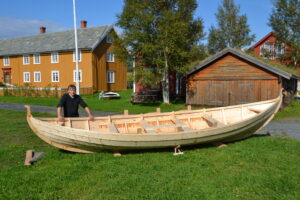
The “boat of the year” for 2020-21 at the museum Kystens Arv ( Coastal Heritage) in Norway, Trøndelag County is a faroese boat. The boat is a “fyremannafar” made by faroese boatbuilder Hanus Jensen. Photo: Museet Kystens Arv
Sources and links:
Header photo: This is a wooden rowboat from Vágur, Suðuroy, Faroe Islands. Sámal Hansen, boat builder built it in 2003. The boat belongs to Vágs Kappróðrarfelag (The Rowing Club of Vágur). Source Wikimedia Commons. Photo: Eileen Sandá Link:https://commons.wikimedia.org/wiki/File:Smyril_a_wooden_rowboat_from_V%C3%A1gur_in_the_Faroe_Islands.JPG
Andras Mortensen: The Faroese Rowing Boat. Maritime culture in the Faroe Islands in the old days. (Hin føroyski róðrarbáturin. Sjómentir føroyinga í eldri tíð), Tórshavn 2000
The National Museum (Tjóðsavnið) collection of pictures and documents about the Faroese boat, www.tjodsavnid.fo
The “boat of the year” for 2020-21 at the museum Kystens Arv ( Coastal Heritage) in Norway, Trøndelag County is a faroese boat. The boat is a “fyremannafar” made by faroese boatbuilder Hanus Jensen. Årets båt – Kystens Arv
The state parties in the Nordic countries have nominated Nordic Clinker Boats traditions to be inscribed on the UNESCOs Representative List of the Intangible Cultural Heritage of Humanity. Read more here: Nordic Clinkerboat Traditions (nordicclinkerboats.org)
Relevant earlier articles from safeguardingpractices.com:
Safeguarding Practices Square rig sailing seminar
Safeguarding Practices Oselvar boat, reframing a traditional learning process
Safeguarding Practices Vitafélag – Promoting Coastal culture
